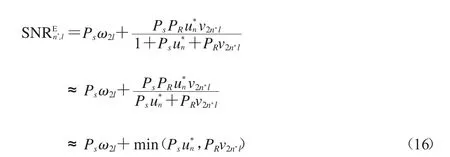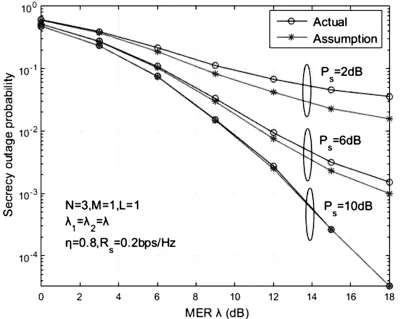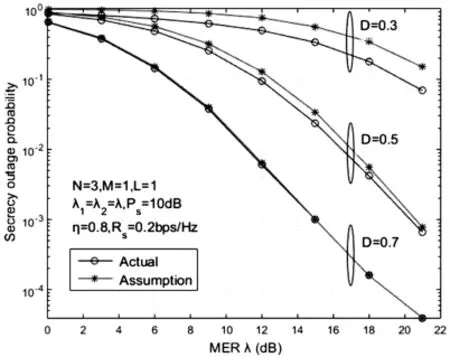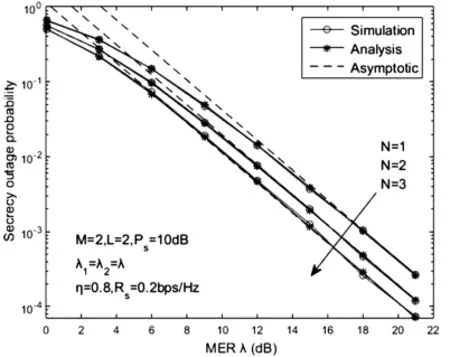中继直达联合影响下多用户AF协作网络的安全通信
2017-07-31夏隽娟林晓升
夏隽娟,林晓升,张 杰
(1.广州大学计算机科学与教育软件学院,广东 广州 510006 2.汕头大学工学院计算机系,广东 汕头 515063)
中继直达联合影响下多用户AF协作网络的安全通信
夏隽娟1,林晓升1,张 杰2
(1.广州大学计算机科学与教育软件学院,广东 广州 510006 2.汕头大学工学院计算机系,广东 汕头 515063)
针对多用户放大转发(Amplify-and-Forward,AF)协作网络,网络的窃听节点监听到目标传输信号,给系统的信息安全带来严重的隐患.尤其在直达链路存在的情况下,窃听节点可以通过直达与中继链路窃听信息.为了提升网络的安全性能,本文提出了一种最优中继和用户选择标准,选择最佳的中继与用户节点进行通信.为了分析系统的安全性能,本文给出了网络保密中断概率闭式表达式和高主窃比(Main-to-Eavesdropper Ratio,MER)下的渐进表达式.从渐进表达可以看出,系统的分集增益等于目标用户数,而与中继数和窃听用户数无关.仿真结果表明,所给出的闭式表达式与仿真结果相符,验证了研究的精确性.
多用户通信;多中继协作网络;多窃听用户;直达链路;放大转发;保密中断概率
0 引言
由于无线传输的广播特性,窃听者在通信过程中可以窃听信道信息,给通信带来了严重的安全威胁.为防止窃听,物理层安全通信已考虑实现信息理论安全传输.Wyner于1975年首次提出了窃听信道的数学模型[1].此后,各种衰落信道的保密性能得到深入研究,文献[2-3]研究了独立瑞丽衰落信道下的无线通信系统的保密性能,文献[4-5]考虑了一种相关瑞丽衰落信号窃听模型,研究了信道相关对保密容量和中断概率的影响,文献[6-8]对Rician和Nakagami-m衰落信道的保密性能进行了研究.文献[9-12]利用各种天线选择技术来增强多输入多输出(Multiple-Input Multiple-Output,MIMO)系统的安全性能[9-12],其中文献[12]研究了在多输入单输出正交频分复用(Multiple-Input-Single-Output Orthogonal-Frequency-Division-Multiple-Access,MISO-OFDMA)系统中,利用用户选择和资源分配技术来使系统的保密速率最大化.此外,中继技术也相继用来提高无线通信系统的保密性能[13-25],如放大转发和解码转发(Decode-and-Forward,DF)中继协议广泛应用在物理层安全通信中[26-31].文献[30]在多AF中继的协作网络下,研究了中继选择对截获概率的影响.文献[32]在多AF协作中继的多用户通信系统下,提出了一种有效增强系统保密性能的最优中继和用户选择算法.
在无线通信系统中,中继和直达联合影响的协作网络是一种典型的通信模型,对此模型的保密性能研究是一个亟待解决的问题.本文针对此问题,考虑了一种多AF中继的多用户协作网络,并存在多个能从基站截获信息的窃听用户.此外,系统处于中度阴影环境中,存在从基站到目标用户和窃听用户的直达链路.本文通过选择最优的用户和中继组合来使目标用户的接收信噪比最大化,以降低系统的保密中断概率.为研究选择技术对系统保密性能的影响,本文推导了系统保密中断概率的解析表达式并给出了高主窃比(MER)下的渐进表达式.从渐进表达式中,可知系统的分集增益等于目标用户数.仿真结果表明,本文推导的系统保密中断概率的解析值与仿真值相符.
1 系统模型

假设第m个用户Dm和第n个中继节点Rn用于信息传输.详细的信息传输过程如下:在第一跳中,基站BS发送归一化信号s,目标用户Dm、AF中继节点Rn和窃听用户El分别接受信号.

图1窃听环境下多用户AF协作网络的系统模型

其中,Ps是基站的传输功率,hBS,Dm~CN(0,ε1),hBS,Rn~CN(0,α)和hBS,El~CN(0,ε2)分别表示链路BS→Dm,BS→Rn和BS→El的信道参数.n1,Dm~CN(0,1),nRn~CN(0,1)和n1,El~CN(0,1)分别表示Dm,Rn和El处的高斯白噪声.
在第二跳中,AF中继节点Rn将信号yRn放大κ倍后转发,目标用户Dm和窃听用户El分别接受的信号如下:

其中,PR是中继节点的传输功率,hRn,Dm~CN(0,β1)和hRn,El~CN(0,β2)分别表示链路Rn→Dm和Rn→El的信道参数.n2,Dm~CN(0,1)和n2,El~CN(0,1)分别表示第二跳中Dm和El处的高斯白噪声.
从以上表述中,我们可以得出目标用户Dm和窃听用户El的信噪比:

观察表达式(7)和(8),目标用户Dm和窃听用户El的信噪比存在一个相关变量un,导致保密中断概率的精确表达式难于求解.为解决此问题,本文考虑了一种高传输功率、窃听用户与中继的距离较大时的情景.令基站与窃听用户间的距离为单位1,窃听用户与中继的距离为D(0<D<1),则α=(1-D)-4,β2=D-4,随着D的逐渐增大,β2逐渐减小而α逐渐增大,相应地,v2nl逐渐减小而un逐渐增大,而当D较大时,un≫v2nl,则窃听用户El处的信噪比可近似为:

此时Dm和El处的信噪比近似为互相独立.
2 中继和用户选择

利用近似


当传输功率Ps和PR很大时,近似误差可忽略不计.此外本文还利用

来定义一个次优的中继和用户选择标准,如下所示:

当目标信道与窃听信道的瞬时容量之差低于给定的目标保密速率Rs时,保密中断事件发生:

即

其中

3 保密中断概率
3.1 解析表达式
根据次优选择标准(13),我们推导系统保密中断概率(Secrecy Outage Probability,SOP)的解析表达式:

式.Y1和Y2的概率密度函数(Probability Density Function,PDF)如定理1和定理2所示:定理1:Y1的PDF如下:

其中

证明:参考附录A
定理2:Y2的PDF如下:

其中

证明:参考附录B
将Y1和Y2的PDF代入公式(17),我们推导出系统保密中断概率的解析表达式:

3.2 渐进表达式
在本节中,我们推导出高MER下的系统渐进保密中断概率.Y1的渐进累计分布函数(Cumulative Distribution Function,CDF)如下:

详细的证明过程参考附录C.
将Y1的渐进CDF和Y2的PDF代入公式(17),可推导出系统保密中断概率的渐进表达式:

4 仿真结果
在本章中,我们给出了各种仿真结果,以更好地验证本文的研究.设系统中所有的链路都经历瑞利平坦衰落,主链路的平均信道增益为α=1,β1=1,ε1=0.5,AF中继与基站的功率比η=0.8,保密数据率Rs=0.2 bps/Hz,即保密信噪比阈值γth=1.32.
仿真结果分为两部分,其中图2-3为本文所考虑情景的适用性验证,图4-6为所推导的系统保密中断概率的解析表达式和渐进表达式的准确性验证.

图2不同传输功率下的保密中断概率

图3窃听用户与中继的距离对保密中断概率的影响


图4用户数量对保密中断概率的影响

图5中继数量对保密中断概率的影响
图4给出了当N=2,L=2,Ps=10 dB,1=2=,目标用户数M从1增加到3时,系统保密中断概率与MER的曲线图.可以看出,系统在不同用户数下的保密中断概率解析值与仿真值几乎重合,随着MER的提高,保密中断概率的渐进值收敛于解析值,这也验证了本文推导的系统保密中断概率的解析表达式和渐进表达式的准确性.另一方面,随着目标用户数的增加,系统的保密中断概率快速下降,曲线斜率随着M线性增加,表明了系统的分集增益等于M.



图6窃听用户数量对保密中断概率的影响
5 结论
本文提出了一种增强接收端存在多个窃听者的多用户AF中继协作网络的保密性能的次优中继和用户选择算法.从更符合实际的观点出发,我们考虑了一个中度衰落环境,存在从基站到目标用户和窃听用户的直达链路.为研究系统的保密性能,本文对保密中断概率的解析表达式和高MER下的渐进表达式进行了推导,从渐进分析中可知系统的分集增益等于目标用户数.因此,在实际的通信环境下,可以通过增加用户的数目显著提升网络的安全传输性能,对系统进行优化设计.
附录A
定理1证明


其中

而M个变量{Y1m1≤m≤M}相互独立.我们进而推导Y1m的CDF,θm的CDF为:



Y1m的CDF可表示为:



其中a0和an的定义如公式(19)所示.Y1是M个独立变量{Y1m1≤m≤M}的最大值,因此Y1的CDF可表示为:

附录B
定理2证明
我们用Y2l表示




Y2l的CDF可表示为:



进一步得出Y2的CDF:

其中bl的定义详见公式(21).
附录C

公式(23)证明

将(C.1)代入(A.5),可得出Y1m的渐进CDF:

其中

Y1的渐进CDF是Y1m的渐进CDF的M次方,表达式如下:

其中

[1]WYNER A D.The wire-tap channel[J].Bell Syst Tech J,1975,54(8):1355-1387.
[2]BLOCH M,BARROS J,RODRIGUES MR D,et al.Wireless information theoretic security[J].IEEE Trans Inf Theory,2008,54(6):2515-2534.
[3]GOPALA P K,LAI L,EL GAMAL H.On the secrecy capacity of fading channels[J].IEEE Transactionson Information Theory,2008,54(10):4687-4698.
[4]JEON H,KIM N,CHOI J,et al.Bounds on secrecy capacity over correlated ergodic fading channels at high SNR[J].IEEE Transactions on Information Theory,2011,57(4):1975-1983.
[5]SUN X,WANG J,XU W,et al.Performance of secure communications over correlated fading channels [J].IEEE Signal Processing Letters,2012,19(8):479-482.
[6]LI J,PETROPULU A P.Ergodic secrecy rate for multiple-antenna wiretap channels with Rician fading [J].IEEE Transactions on Information Forensics and Security,2011,6(3):861-867.
[7]LIUX.Probabilityofstrictlypositive secrecy capacity of the Rician-Rician fading channel[J].IEEE Wireless Communications Letters,2013,2(1):50-53.
[8]SARKAR M Z I,RATNARAJAH T.Secure communication through Nakagami-m fading MISO channel [C],Proceedings of IEEE ICC,June 5-9,2011.DOI:10.1109/icc.2011.5963506.
[9]ALVES H,SOUZA R D,DEBBAH M,et al.Performance of transmit antenna selection physical layer security schemes[J].IEEE Signal Processing Letters,2012,19(6):372-375.
[10]YANG N,YEOH P L,ELKASHLAN M,et al.Transmit antenna selection for security enhancement in MIMO wiretap channels[J].IEEE Transactions on Communications,2013,61(1):144-154.
[11]YANG N,YEOH P L,ELKASHLAN M,et al.MIMO wiretap channels:Secure transmission using transmitantenna selection and receive generalized selection combining[J].IEEE CommunicationsLetters,2013,17(9):1754-1757.
[12]LUO W Y,JIN L,HUANG K Z,et al.User selection and resource allocation for secure multiuser MISO-OFDMA systems[J].Electronics letters,2011,47(15):884-886.
[13]FAN L,LEIX,HU R Q,et al.Outdated relayselection in two-wayrelay network[J].IEEE Transactions on Vehicular Technology,2013,62(8):4051-4057.
[14]FAN L,LEI X,DUONG T Q,et al.Multiuser cognitive relay networks:Joint impact of direct and relay communications[J].IEEE Transactions on Wireless Communications,2014,13(9):5043-5055.
[15]GAOF,JIANGB,GAOX,etal.SuperimposedtrainingbasedchannelestimationforOFDMmodulated amplify-and-forwardrelaynetworks[J].IEEETransactionsonCommunications,2011,59(7):2029-2039.
[16]GAO F,ZHANG R,LIANG Y C.Channel estimation for OFDM modulated two-way relay networks[J]. IEEE Transactions on Signal Processing,2009,57(11):4443-4455.
[17]ZHANG H,SHU-HUNG L,GAO S,et al.Doubly selective channel estimation for OFDM modulated amplify-and-forward relay networks using superimposed training[J].EURASIP Journal on Wireless Communications and Networking,2012,2012(1):249.
[18]ZhangS,Liew SC.Channel codingand decoding in a relay system operated with physical-layer network coding[J].IEEE Journal on Selected Areas in Communications,2009,27(5):788-796.
[19]ZHANG S,LIEW S C,WANG H.Blind known interference cancellation[J].IEEE Journal on Selected Areas in Communications,2013,31(8):1572-1582.
[20]HUANG S,CHEN H,ZHANG Y,et al.Energy-efficient cooperative spectrum sensing with amplifyand-forward relaying[J].IEEE Communications Letters,2012,16(4):450-453.
[21]HUANG S,CHEN H,ZHANG Y,et al.Sensing-energytradeoffin cognitive radio networkswith relays [J].IEEE systems journal,2013,7(1):68-76.
[22]WANG H M,YIN Q,XIA X G.Distributed beamforming for physical-layer security of two-way relay networks[J].IEEE Transactions on Signal Processing,2012,60(7):3532-3545.
[23]WANG H M,LUO M,XIA X G,et al.Joint cooperative beamforming and jamming to secure AF relay systems with individual power constraint and no eavesdropper's CSI[J].IEEE Signal Processing Letters,2013,20(1):39-42.
[24]WANG H M,LUO M,YIN Q,et al.Hybrid cooperative beamforming and jamming for physical-layer securityoftwo-wayrelaynetworks[J].IEEE Transactionson Information Forensicsand Security,2013,8(12):2007-2020.
[25]DONG L,HAN Z,PETROPULU A P,et al.Improving wireless physical layer security via cooperating relays[J].IEEE Transactions on Signal Processing,2010,58(3):1875-1888.
[26]MO J,TAO M,LIU Y.Relay placement for physical layer security:A secure connection perspective [J].IEEE Communications Letters,2012,16(6):878-881.
[27]BAO V N Q,LINH-TRUNG N,DEBBAH M.Relay selection schemes for dual-hop networks under securityconstraintswithmultipleeavesdroppers[J].IEEE transactions on wireless communications,2013,12(12):6076-6085.
[28]KRIKIDIS I,THOMPSON J S,MCLAUGHLIN S.Relay selection for secure cooperative networks with jamming[J].IEEE Transactions on Wireless Communications,2009,8(10):5003-5011.
[29]KRIKIDIS I.Opportunistic relay selection for cooperative networks with secrecy constraints[J].IET Communications,2010,4(15):1787-1791.
[30]ZOU Y,WANG X,SHEN W.Optimal relayselection forphysical-layer security in cooperative wireless networks[J].IEEE Journal on Selected Areas in Communications,2013,31(10):2099-2111.
[31]YANG Y,LIQ,MA W K,et al.Cooperative secure beamforming for AF relay networks with multiple eavesdroppers[J].IEEE Signal Processing Letters,2013,20(1):35-38.
[32]FAN L,LEIX,DUONG T Q,et al.Secure multiuser communications in multiple amplify-and-forward relay networks[J].IEEE Transactions on Communications,2014,62(9):3299-3310.
Joint Impact of Relaying and Direct Links on Secure Multiuser Amplify-and-Forward Relay Networks
XIA Junjuan1,LIN Xiaosheng1,ZHANG Jie2
(1.School of Computer Science and Educational Software,Guangzhou University,Guangzhou 510006,Guangdong,China; 2.Department of Computer Science,Shantou University,Shantou 515063,Guangdong,China)
For multiuser multiple amplify-and-forward(AF)relaynetworks,the eavesdroppers in the networks can overhear the secure message of the target user,which brings out the severe issue of information security.In particular,when the direct links exist,the eavesdroppers can overhear the message through both relaying and direct links.To enhance the secure performance of this network,the best selection criterion for user and relay selection is proposed and the closed-formexpression ofthe secrecyoutage probabilityas well as the asymptotic expression with high main-to-eavesdropper ratio(MER)are derived.Fromthe asymptotic analysis,the systemcan achieve the diversity of the number of the users,irrespective of the number of the relays and eavesdroppers.Numerical results show that the closed-form expression fits well with the simulation results,which verify the accuracy of the studies.
multiuser communication;multi-relaycooperative networks;multiple eavesdroppers; direct links;amplify-and-forward(AF);secrecy outage probability
TN925+.1
A
1001-4217(2017)03-0061-11
2017-05-10
夏隽娟(1981—),女(汉族),安徽芜湖人,助理实验师,主要研究方向为网络通信. E-mail:xiajunjuan@gzhu.edu.cn
国家自然科学基金资助项目(61372129)
